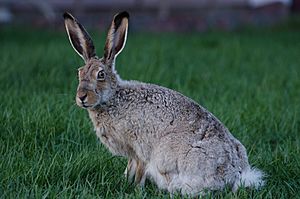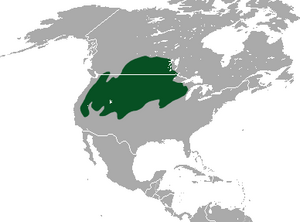White-tailed jackrabbit facts for kids
Quick facts for kids White-tailed jackrabbit |
|
|---|---|
 |
|
| Conservation status | |
| Scientific classification | |
| Genus: |
Lepus
|
| Species: |
townsendii
|
 |
|
| White-tailed jackrabbit range | |
The white-tailed jackrabbit (Lepus townsendii) is a type of hare that lives in western North America. People also call it the prairie hare or the white jack. Like all hares and rabbits, it belongs to the family called Leporidae. This family is part of a larger group called Lagomorpha.
White-tailed jackrabbits usually live alone. But during the breeding season, several males might gather to find a female. Females give birth to four or five young. They make a simple nest called a "form." This is a shallow dip in the ground, hidden by plants. There are two main types of white-tailed jackrabbits. One lives west of the Rocky Mountains. The other lives east of the Rocky Mountains.
Contents
About the White-Tailed Jackrabbit
The white-tailed jackrabbit is a large hare. It is the biggest species known as a "jackrabbit." However, two other hares, the Arctic hare and Alaskan hare, are even larger. They live further north.
Adult white-tailed jackrabbits are about 56 to 65 centimeters (22 to 26 inches) long. Their tail adds another 6.6 to 10.2 centimeters (2.6 to 4 inches). They usually weigh between 2.5 and 4.3 kilograms (5.5 and 9.5 pounds). Females often weigh more in spring because they might be pregnant. Males might weigh less due to the stress of finding a mate.
These jackrabbits have large, gray ears with black tips. The inside of their ears is chestnut brown and white. They have strong back legs, which help them run fast. Their fur is dark brown or grayish-brown on their back and sides. Their belly is pale gray. Their tail is white with a dark stripe on top. Females are a bit bigger than males.
In colder northern areas, these hares change their fur in autumn. They become completely white, except for their ears. This helps them blend in with the snow. White-tailed jackrabbits usually do not make sounds. But if they get hurt or caught, they might let out a loud scream.
Where They Live and Their Homes
The white-tailed jackrabbit lives in western and central North America. You can find them in parts of Canada like British Columbia and Alberta. They also live in many U.S. states, including Washington, Oregon, and Colorado.
They prefer open areas like plains and prairies. They also live in high mountain meadows. These areas often have scattered evergreen trees. They can live at elevations up to about 3,000 meters (10,000 feet).
The white-tailed jackrabbit is a bit larger than the black-tailed jackrabbit. If their living areas overlap, they usually stay in different places. White-tailed jackrabbits prefer higher, cooler areas. Black-tailed jackrabbits like drier, lower lands.
Sometimes, people see these jackrabbits in city parks in Western Canada. In spring, people might find young bunnies alone. They might think the mother has left them. But usually, the mother is nearby. Animal shelters, like the Edmonton Humane Society, ask people not to bring these bunnies in.
Daily Life and Habits

White-tailed jackrabbits are mostly active at night. During the day, they rest in a "form." This is a shallow dip in the ground. They hide it under plants. These forms are usually about 46 to 61 centimeters (18 to 24 inches) long. They are 20 to 30 centimeters (8 to 12 inches) wide. They can be up to 20 centimeters (8 inches) deep.
You might see small paths leading from their forms. Other paths connect to their favorite feeding spots. In winter, when there is snow, their forms can become like small, connected caves.
These jackrabbits live alone. They eat grasses and other green plants. They also eat crops grown by farmers. In winter, they eat buds, twigs, and bark from small shrubs. They are pickier eaters than black-tailed jackrabbits. This can be a problem if they live in the same area.
White-tailed jackrabbits have good eyesight and excellent hearing. Their whiskers are very sensitive. They can probably smell if another jackrabbit is ready to breed.
Reproduction and Life Cycle
The breeding season for white-tailed jackrabbits changes. It depends on where they live and the weather. It can last from February to July in different places.
Several male jackrabbits might fight to get a female's attention. They charge at each other, jump, and push. The female releases her eggs after mating. Pregnancy lasts about 42 days. Before giving birth, the female makes a fur-lined nest. She hides it under thick plants.
A female can have up to 11 young, but four or five is more common. The baby jackrabbits, called leverets, weigh about 100 grams (3.5 ounces) at birth. They are born with their eyes open and full fur. They can move around very soon after birth.
They start looking for food when they are about two weeks old. They stop drinking their mother's milk at four weeks. They can have their own babies when they are about seven months old. But they usually wait until the year after they are born to breed.
Jackrabbits in Nature
White-tailed jackrabbits help shape the land by choosing which plants to eat. They are also an important food source for many other animals.
Smaller predators like red foxes and gray foxes sometimes catch them. But they usually do not catch large adult jackrabbits. Jackrabbits are a key food for mid-sized animals. These include the American badger, the coyote, and the bobcat. They can also be a small part of the diet for larger predators. These include the mountain lion and the gray wolf.
Snakes sometimes attack young jackrabbits. Birds like eagles, hawks, and owls also hunt them. Golden eagles are big enough to regularly catch adult white-tailed jackrabbits. Other large birds, like ferruginous hawks and great horned owls, might catch an adult sometimes. But they usually hunt young jackrabbits.
Jackrabbits try to avoid being seen by crouching in plants. Their fur color helps them blend in. If they are spotted, they run away very fast. They run in a zigzag pattern to confuse predators. They can run up to 55 kilometers per hour (34 miles per hour). They can also leap up to 5 meters (16 feet). Humans also hunt and eat them.
Their Conservation Status
The IUCN says the white-tailed jackrabbit is of "Least Concern". This means they are not currently in danger of disappearing. They live in a large area and are fairly common. Their numbers might be going down a little. But it is not a fast enough decline to put them in a more threatened group.
However, in Wyoming, they have become rare in Grand Teton National Park. They have not been seen there recently. For a while, people thought they had disappeared from Yellowstone National Park. They used to be very common there. But now, people have seen them. They have also found jackrabbits hit by cars. This shows they are still in the park. It is not clear why their numbers are going down in Wyoming.
Images for kids
See also
 In Spanish: Liebre de cola blanca para niños
In Spanish: Liebre de cola blanca para niños




